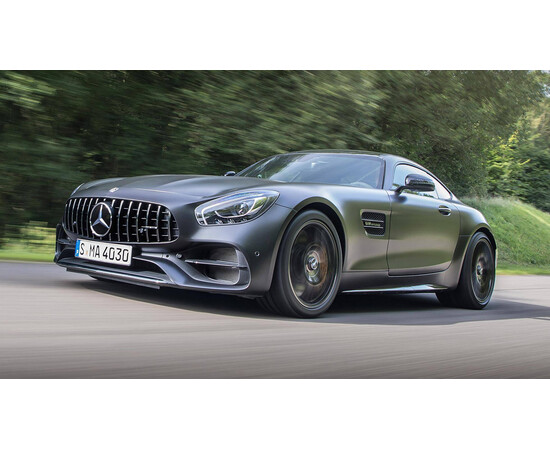
- — Trusted Since 2018
- — Competitive Prices
- — Delivery To 125+ Countries
- — Certified Authentic Products
- — 24/7 Customer Support
- — Order Tracking via Email & SMS
Think of it as the facelifted AMG GT. Three years have passed since Mercedes-AMG first showed off its two-seater hot rod and now the guys and girls at Affalterbach have given it a mid-life nip and tuck. The distinctive ‘Panamericana’ grille with its wide-spaced vertical slats is the giveaway; pre-facelift cars have a single horizontal spar across a wide open snout.
The GT range is now nine-strong, if you count all variants across Coupe and Roadster body styles, plus the GT3 and GT4 racing cars. The GT Coupe sits at the foot of the line-up, its £98,760 asking price the only one to dip below six-figures. Next is the GT Roadster, costing £110,160.
Then it goes £112,060 GT S Coupe - there is no GT S Roadster - after which there’s a big step up in list price to the GT C Coupe Edition 50, which costs £139,855. Remember that version - it might well be the pick of the entire range. Edition 50, incidentally, signifies the limited edition models that celebrate 50 years of Mercedes’ AMG performance division. They get subtle badging and a choice of bespoke paintwork options, and not much else. When those limited run models are sold out the Edition 50 tag will be dropped and the corresponding model will slot into the main GT line-up, minus a big chunk of list price.
There is a GT C Roadster, which costs £139,460, while the Edition 50 version carries a hefty £11,795 premium. Right at the top of the range is the snarling, bewinged GT R, which is basically AMG’s hostile pop at Porsche’s 911 GT3 and GT3 RS track monsters. Curiously, though, the GT R is actually cheaper than the GT C Roadster Edition 50, with a list price of £143,260.
Yes, it’s all a bit confusing. Unlike the Porsche 911 or Jaguar F-Type lineups, though, all AMG GTs use the same basic twin-turbo V8 engine - just with different power outputs - and all of them are rear-wheel drive.
Regardless of spec or power output, all AMG GTs have the same basic feel out on the road. That’s because you sit right over the rear axle with acres of car reaching out ahead of you. A skilful pilot could probably land a light aircraft on the bonnet of an AMG GT. The distance between you and the front wheels can be a little intimidating at first and you can’t actually see where the front of the car stops, but you do very quickly get used to it.
What helps no end is the location of the engine. It’s mounted so far back in the chassis that it nestles beneath the dashboard as much as the bonnet; if Mercedes had put a little flap in the dash you could probably check the oil level without unbuckling your seatbelt. Technically the AMG GT is front-mid engined, so it isn’t as woefully nose-heavy as those signature proportions suggest. In fact, it can be freakishly agile.
Early GTs were characterised by steering that was so flighty and hyperactive that you had to recalibrate your mind entirely just to avoid pointing the thing into a ditch. For these revised models AMG has retuned the steering, and to brilliant effect. There’s some much needed weight now and a calmer, more predictable response, too. The very long front end does still mean you pour the car into a bend rather than really fling it in, but at least the more fluid steering helps you to do so without driving clean off the road and into an orchard, or whatever.
The GT and GT S models are much more composed and settled at the rear end now, too, whereas before they seemed to flop and roll around too much. On smooth roads, these cars are now immensely flat-bodied and brilliantly tied down. Rear-wheel steering is one of the key AMG GT technologies. It’s not available on the GT, optional on the GT S and standard on all other models. All you need to know is it makes the car feel sharper and more agile in medium and low speed bends, helping to negate the slightly disconcerting effect of that very long bonnet.
The hotter GT C and GT R models have wider rear tracks with swollen arches that add truck loads of visual muscle. Once seen, you can’t un-see how weedy the lesser models look by comparison. Those wider tracks help the GT C and GT R to be more stable and precise in really hard cornering. If you love driving, these are the models to aspire to.
With its active aero and track-biased tyres the GT R is the fastest and most aggressive of the lot. It is brilliantly entertaining to chuck around a circuit, but it doesn’t have the poise or composure of a 911 GT3 RS.
What of the Roadster models? Despite losing their roofs they don’t feel wobbly and there’s very little sense of the structure shuddering over rough patches of road. But you can really sense the extra 55kg - in the base GT Roadster you constantly feel like you’re a gear higher than you really are - and they just aren’t as sharp or agile as a result.
The twin-turbo V8 engines, meanwhile, are very impressive regardless of power output. They’re all muscular, responsive and energetic right up near the 7,000rpm redline. The aggressively popping, crackling exhaust notes may be a little contrived, but at least the soundtrack isn’t all flat, monotone turbo blare. The twin-clutch gearboxes, meanwhile, are wonderfully snappy and responsive.
Power starts at 469bhp in the entry-level GT and steadily rises to 577bhp in the fire-spitting GT R.
The GT’s cabin is one of its signature features. You sit so low, with the steering wheel just where you want it and your feet way out ahead of you. The seating position is basically very good and the seats themselves are supportive, but they’re also quite unyielding. After a long drive you’ll know you’ve been sat in a high performance car and not a limo.
The interior design is very modern and attractive, with a high transmission tunnel that makes a snug cocoon of each side of the cabin. The two banks of four round buttons on the centre console cleverly evoke the layout of a V8 engine. Overall the quality is very good, although some of the optional trim can look a little cheap and brittle.
Mercedes’ infotainment system is one of the better ones out there. It’s intuitive and easy to navigate. There’s a reasonable amount of storage space in the cabin, but the boot is very shallow - that’s because the gearbox is mounted immediately below the boot floor.
With improved steering and a more composed rear end, the AMG GT is now a very compelling sports car. The GT C Coupe is undoubtedly the pick of the range, combining the usability of the GT S with the aggressive styling and dynamic precision of the GT R. We’d advise waiting for the Edition 50 models to sell out, though, because the near-£12,000 premium is hard to justify.
Finally, a word of warning. On smooth German roads the higher performance models didn’t feel unreasonably stiff, but on very bumpy UK roads they will be on the firm side. You can switch back to the softest damper setting regardless of which driving mode you’ve selected, which is good, but it doesn’t suddenly make the chassis fluid and compliant. It’s a bit like applying factor five sunblock in the Sahara desert; it will help - a bit - but don’t expect it to solve the problem.


















